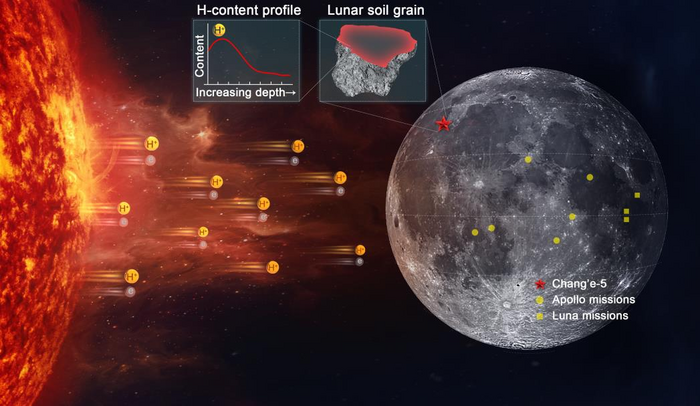Due to its crucial importance in future space exploration, the abundance, distribution and origin of lunar surface water have received a lot of attention recently.

Credit: Prof. LIN Yangting’s group
Due to its crucial importance in future space exploration, the abundance, distribution and origin of lunar surface water have received a lot of attention recently.
A joint research team from the National Space Science Center (NSSC) and the Institute of Geology and Geophysics (IGG), both affiliated with the Chinese Academy of Sciences (CAS), have discovered that the Chang’e-5 lunar soil grain rims have high concentrations of hydrogen and low deuterium/hydrogen (D/H) ratios that are consistent with lunar water originating from the solar wind (SW).
The findings were published in PNAS on Dec. 12, 2022.
The researchers conducted simulations on the preservation of hydrogen in lunar soils at different temperatures. They found that SW-originated water could be well preserved in the middle and high latitude regions of the lunar surface. “The polar lunar soils could contain more water than Chang’e-5 samples,” said Prof. LIN Yangting from IGG, corresponding author of the study.
Previous studies have proved that water (OH/H2O) on the lunar surface varies with latitude and time of day (up to 200 ppm). Such an obvious change implies a rapid desorption rate from the lunar surface.
In contrast to the six Apollo and three Luna missions, which all landed at low latitudes (8.97°S—26.13°N), the Chang’e-5 mission returned soil samples from a middle latitude location (43.06°N). In addition, the Chang’e-5 samples were collected from the youngest known lunar basalts (2.0 Ga) and the driest basaltic basement. Therefore, Chang’e-5 samples are key to addressing the spatial-temporal distribution and retention of SW-derived water in the lunar regolith.
On 17 lunar soil grains returned by the Chang’e-5 mission, the researchers took NanoSIMS depth-profiling measurements of hydrogen abundance and calculated deuterium/hydrogen ratios.
Results showed that the majority of the grain rims (topmost ~100 nm) exhibited high concentrations of hydrogen (1,116—2,516 ppm) with extremely low δD values (-908‰ to -992‰), implying an SW origin. Based on the grain size distribution of the lunar soils and their hydrogen content, the bulk SW-derived water content was estimated to be 46 ppm for the Chang’e-5 lunar soils, consistent with the remote sensing result.
Heating experiments on a subset of the grains demonstrated that the SW-implanted hydrogen could be preserved after burial. Using this information along with previous data, the researchers established a model of the dynamic equilibrium between the implantation and outgassing of SW-hydrogen in soil grains on the moon, revealing that temperature (latitude) plays a key role in the implantation and migration of hydrogen in lunar soils.
Using this model, they predicted an even higher abundance of hydrogen in the grain rims in the lunar polar regions. “This discovery is of great significance for the future utilization of water resources on the moon,” said Prof. LIN. “Also, through particle sorting and heating, it is relatively easy to exploit and use the water contained in the lunar soil.”
Journal
Proceedings of the National Academy of Sciences
DOI
10.1073/pnas.2214395119
Article Title
High abundance of solar wind-derived water in lunar soils from the middle latitude
Article Publication Date
12-Dec-2022




